Video of the Week:
Overseeding your Lawn
Turfgrass:
Give Cool-Season Grasses a Boost
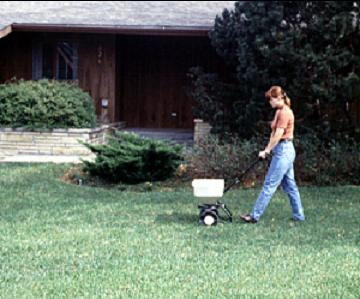
These grasses are entering their fall growth cycle as days shorten and temperatures moderate (especially at night). Cool-season grasses naturally thicken up in the fall by tillering (forming new shoots at the base of existing plants) and, for bluegrass, spreading by underground stems called rhizomes. Consequently, September is the most important time to fertilize these grasses.
Apply 1 to 1.5 pounds of actual nitrogen per 1,000 square feet. The settings recommended on lawn fertilizer bags usually result in about 1 pound of nitrogen per 1,000 square feet. We recommend a quick-release source of nitrogen at this time. Most fertilizers sold in garden centers and department stores contain either quick-release nitrogen or a mixture of quick- and slow-release. Usually only lawn fertilizers recommended for summer use contain slow-release nitrogen. Any of the others should be quick-release.
The second most important fertilization of cool-season grasses also occurs during the fall. A November fertilizer application will help the grass green up earlier next spring and provide the nutrients needed until summer. It also should be quick-release applied at the rate of 1-pound actual nitrogen per 1,000 square feet. (Ward Upham)
Power Raking and Core-Aeration
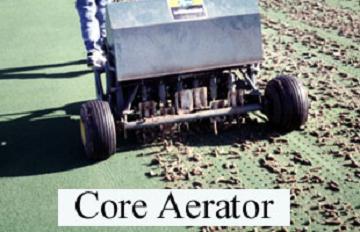
Power raking is primarily a thatch control operation. It can be excessively damaging to the turf if not done carefully. For lawns with one-half inch of thatch or less, I don’t recommend power raking but rather core aeration. For those who are unsure what thatch is, it is a springy layer of light-brown organic matter that resembles peat moss and is located above the soil but below the grass foliage. Power raking pulls up an incredible amount of material that then must be dealt with by composting or discarding.
Core-aeration is a much better practice for most lawns. By removing cores of soil, core-aeration relieves compaction, hastens thatch decomposition, and improves water, nutrient, and oxygen movement into the soil profile. This operation should be performed when the soil is just moist enough so that it crumbles easily when worked between the fingers. Enough passes should be made so that the holes are spaced about 2 to 3 inches apart. Ideally, the holes should penetrate 2.5 to 3 inches deep. The cores can be left on the lawn to decompose naturally (a process that usually takes two or three weeks, depending on soil-type), or they can be broken up with a vertical mower set just low enough to nick the cores, and then dragged with a section of chain-link fence or a steel doormat. The intermingling of soil and thatch is beneficial to the lawn. (Ward Upham)
Flowers:
Peonies May be Cut Back Now
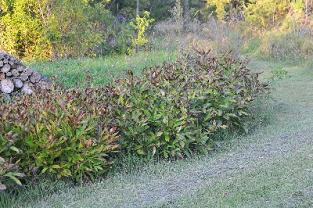
Ornamentals:
Big XII Gardening
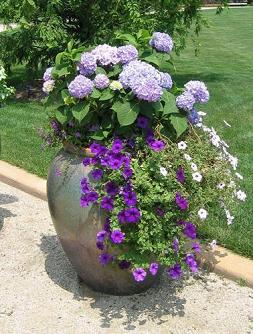
For instant color, consider a container combination with any purple (angelonia, petunia, etc.), white (petunia or vinca) or gray (lambs ears) plants. Make sure they can all be grown in the same sun and water conditions. Check out www.prairiestarflowers.com for more ideas and cultivar recommendations. Go shopping at your local garden center and see what you can find!
For those of you who like to plan ahead, there are many woody plants that may take a few years to mature in your landscape, but are well worth the investment. Most feature purple blooms or purple leaves (specimen plants!). Download the new “Deciduous Shrubs for Kansas” publication (http://www.ksre.ksu.edu/bookstore/pubs/MF3116.pdf), open it on your computer and run a search for “purple” in the document. This should give you plenty of options.
One of the gardeners in my neighborhood celebrates Big XII football every year by painting a small wooden slate in the colors of the teams we will play. He places the blank slates on his fence and, after each game, he paints the score on the no-longer-blank slate. It’s a great visual reminder of something that is important to him and of interest to lots of folks driving by. It also makes interesting and relevant garden art.
How about container gardening in the colors of the Big XII? If you think about it, throughout the 10 teams in the conference, the same colors are used in combination: red, orange, yellow, green, blue, violet, white, gray and black. You could grow containers that each feature a plant with one of these colors, then move them around in different combinations depending on which teams are playing at any given time. Sound like fun?
I had one more thought on Big XII gardening: plant a small arrangement along a fence or in a planting bed for each team in the conference, featuring their colors. Maybe with a scoreboard above it? Well… I suppose it wouldn’t be a particularly great reminder if those flowers were still living long after the results of the game were available. Hmm… Roundup® the plants when we beat them? Ha! JUST KIDDING! (Cheryl Boyer)
Are Crabapples Safe to Eat?
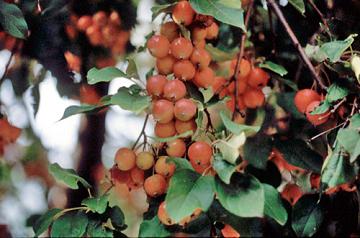
There is one other caveat with using crabapples from a tree in the landscape. Make sure the tree hasn't been sprayed as an ornamental with a pesticide that isn't labeled for fruit tree apples. If it has, then the fruit should not be used. (Ward Upham)
Pests:
Yellowjacket Season is Here
Yellow jacket wasps are ¾” in length and can resemble honey bees from a distance, but have a few distinctions. Yellow jackets are more likely to be around human food, pet food, and compost piles. They tend to nest in the ground, but can also be found in house cavities, tree cavities, or in compost piles which have not been disturbed. Honey bees have more hairs and are usually duller in color.
If you encounter a yellow jacket nest, it is best to leave the area. Yellow jackets are more likely to sting when a nest is near. They will also sting when trying to be swatted at or if accidentally encountered when drinking soda from a can they’ve crawled into.
To prevent encounters, remove attractive sources of food. Keep pet food covered or indoors, especially when not in use. Seal garbage cans and empty regularly. Pick up and dispose of ripe fruit. If you must move something in the area of a nest, it is recommended to do this before dawn or after dusk when yellow jackets are less active. (Sharon Dobesh)
Contributors: Cheryl Boyer, Extension Nursery Crops Specialist; Sharon Dobesh, Associate Director, Plant Pathology; Ward Upham, Extension Associate
 RSS Feed
RSS Feed
